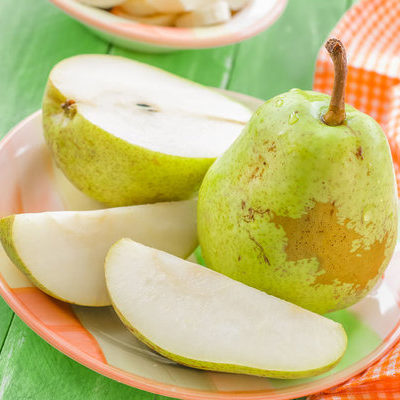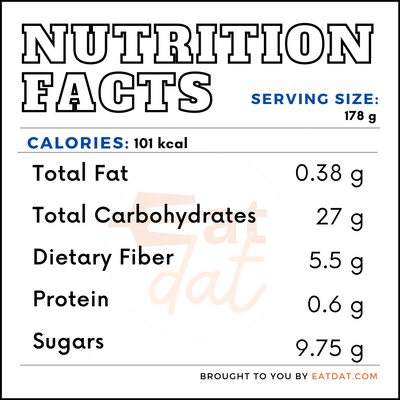
Pear
What is a Pear?
A pear is a fruit with soft skin and soft inner flesh that is consumed all over the world. The ancient Greeks historically used it as a natural cure for nausea. There are over 3,000 variants of this fruit across the globe.
- Several types of this fruit come in different shapes, sizes, and colors.
- All types of pear are grouped into the European and the Asian variety.
The top seven most popular varieties of pear, according to Saveur are:
- Green Anjou
- Red Anjou
- Bartlett
- Red Bartlett
- Bosc
- Concorde
- Seckel
Origin of pears
Many believe that the pear originated in western China in the Tian Shan Mountains’ foothills. The fruit began to spread and developed into around twenty well-known species. Some say that the fruit has its origin in the mildly temperate regions of the ancient world, around North Africa and western Europe. Today, China is the largest producer of this fruit, followed by the United States. People in the United States grow this fruit primarily in orchards. Nowadays, the pear is often canned, dried, or made into juice.
Nutrition
According to the United States Department of Agriculture (USDA), a medium-sized pear (178g) contains:

Pears are rich in vitamins, minerals, and fiber. According to health practitioners, this fruit provides many health benefits, such as:
- Offering a source of copper and potassium, which help nerve function and heart health, respectively.
- The fiber in this fruit can help your digestive system.
- Pears contain antioxidants that help to fight inflammation.
- They also have cancer-fighting properties.
- They can help reduce your chance of developing diabetes.
- This fruit has a low-calorie content and can help you lose weight.
Some people may be allergic to pears, although it is somewhat rare. Some typical symptoms are:
- Itching in the mouth
- Diarrhea
- Itchy skin
- Facial swelling
Commercial production
The commercial production of pears involves planting, fertilizing, and protecting the fruit from disease. The harvesting period of this fruit depends on the variety. In 2014, commercial pear production in the US produced over 1.6 billion pounds of this fruit. The most prevalent type of this fruit in the United States is Bartlett. The American states which produce pears commercially are California, Michigan, New York, Oregon, Pennsylvania, and Washington.
Application
It’s ideal to eat ripe pears to fully enjoy their taste; however, you shouldn’t leave this fruit on the tree until ripe. If left on the tree until ripe, it will develop a grainy texture. When buying this fruit, choose unripe ones with clean skins and store them at home to ripen. Knowing this fruit’s variety will help you predict how long it will take to get ripe.
To check if the fruit is mature, press down the end of the stem to see if it is soft. If that’s the case, then the fruit is ripe. Remember that ripe fruits release ethylene gas. When you bring raw pears in contact with other mature types of fruits, the ripening speed increases because the fruit absorbs the ethylene gas.
If you want to ripen this fruit quickly, place it in a brown paper bag with a ripe apple or banana. Do this only when you are ready to eat the fruit. When storing a bunch of pears, check to see if any have gone bad. A single lousy fruit will spoil the others. The best way to store pear is at a low temperature.
Pear recipes
People use pear in cakes, wines, syrups, salads, smoothies, and many other treats. Below are some delicious recipes you can try.
- Poached pears in spiced red wine
- Flourless chocolate & pear cake
- Warm beet, chorizo & pear salad
- Chocolate pear crisp
- Chocolate pear pudding
- Apple, pear & walnut crumble
FDA regulations
The Food and Drug Administration classifies this fruit as a raw agricultural commodity and regulates all aspects of its growing, harvesting, and packing. They also have a standard of identity for canned pears and define them as food prepared from specific fresh or canned pear ingredients. There are regulations concerning the preparation and labeling of canned pears. The FDA also has a standard of identity for artificially sweetened canned pears. The distinguishing factor for artificially sweetened canned pears is that the packing medium is water artificially sweetened with saccharin or sodium saccharin.
References
Wartenberg, Lisa. “9 Health and Nutrition Benefits of Pears.” Healthline.com, Healthline Media, 12 July 2019, www.healthline.com/nutrition/benefits-of-pears.
“CFR – Code of Federal Regulations Title, 21.” Accessdata.fda.gov, U.S Food & Drug Administration, 1 Apr. 2019, www.accessdata.fda.gov/scripts/cdrh/cfdocs/cfcfr/CFRSearch.cfm?fr=145.175.
